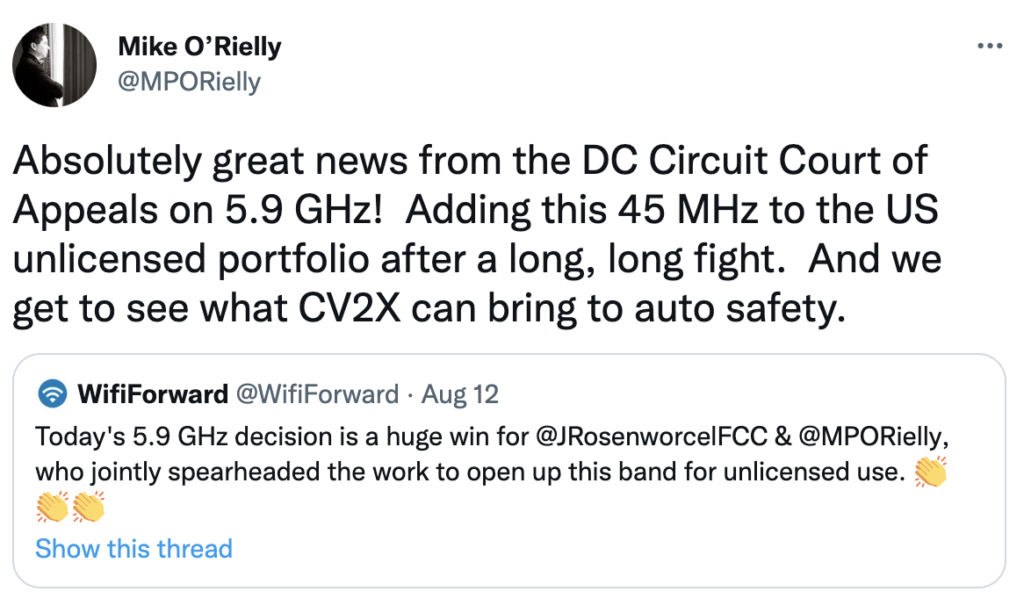ICYMI: Last week, the DC Circuit unanimously upheld the FCC’s decision to allow Wi-Fi and other unlicensed operations in 45 MHz of the 5.9 GHz band, which had previously been allocated exclusively to the auto industry. Since that ruling, there has been an outpouring of support from the FCC and other groups from both sides of the aisle.

“I am pleased with the Court’s decision, which upholds the FCC’s broad authority to manage the nation’s airwaves in the public interest,” FCC Chairwoman Jessica Rosenworcel said in a statement. “In the more than two decades since the FCC allocated the 5.9 GHz band to support automobile safety, autonomous and connected vehicles have largely moved beyond dedicated, short-range communications technologies to newer, market-driven alternatives. Today’s decision recognizes that by allowing this spectrum to evolve we can advance newer safety technologies and grow our wireless economy.”
Echoing Rosenworcel, FCC Commissioner Brandon Carr said he was “very pleased” with the decision and FCC Commissioner Geoffrey Starks touted there was “no ceiling on the possibilities that come next.” Elsewhere, former high-ranking members of the FCC including Ajit Pai (former Chairman), Mike O’Reilly (former Commissioner) and Matthew Berry (former Chief of Staff and General Counsel) all tweeted in support of the decision.
Additionally, many third-party organizations touted the outcome of last week’s ruling and emphasized the FCC’s spectrum allocation authority.
“The court’s decision today emphasizes that the FCC has broad authority over spectrum allocation,” Joe Kane, Director of Broadband and Spectrum Policy at the Information Technology and Innovation Foundation said in a statement. “Industries and other federal agencies deserve to be heard in this process, but the FCC is the agency with the technical and policy expertise to analyze those views and make the tradeoffs that are inherent in commercial spectrum allocation.”
“Unsurprisingly, the D.C. Circuit reinforced its similar decision last December, concerning the 6 GHz band, that the FCC has wide discretion to authorize unlicensed sharing of underutilized spectrum or, in this case, to reallocate a portion of a lightly-used band to provide more bandwidth for next generation Wi-Fi,” Michael Calabrese, director of the Wireless Future Program at the Open Technology Institute at New America said.
NCTA called the decision a “huge victory” and looks forward to “working with the Commission to build on this positive momentum and complete the 5.9 GHz proceeding.” Wi-Fi Alliance shared this sentiment, stating that the decision “removes the regulatory uncertainty surrounding use of the 5.9 GHz band, [and enables] Wi-Fi Alliance members to expedite delivery of urgently needed Wi-Fi solutions.”
Other groups expressed excitement over the decision for reaffirming the FCC’s authority over spectrum decisions and its engineering expertise.
“The D.C. Circuit’s opinion is a victory for the public interest,” Kathleen Burke, Policy Counsel at Public Knowledge said. “Not only did the court reaffirm the FCC’s authority as the expert agency over spectrum decisions, but it also upheld the FCC’s correct call to stop bankrolling the auto industry’s speculation on Intelligent Transportation Services that were still in development after more than 20 years.”
“This decision is emblematic of the respect courts have for the FCC’s engineering and process,” Joel Thayer, President of Digital Progress Institute tweeted. He went on to say this decision is a “Big win!”
“Focus of the court is whether the FCC considered, in consultation with the Sect. of Transportation, spectrum needs for the operation of intelligent transportation systems,” Jeff Westling, Director of Technology and Innovation Policy at American Action Forum said. “Pretty clearly it did.”
The optimism surrounding the decision is symbolic of the industry already innovating to utilize the band. Two devices already on the market — a gaming router from Asus and a tri-band router from Synology — have the capabilities to use the 5.9 GHz spectrum.
With this ruling, the door is now open for much more innovation benefiting American consumers.
